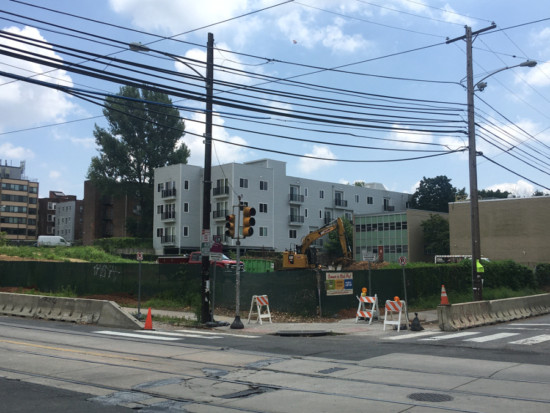Here’s a quick update on our last month’s post regarding the development of a 132-unit residential complex at 43rd and Baltimore (4224 Baltimore Ave) across from Clark Park.
Developers announced in June that they were finally moving forward with the construction. The work began promptly after the announcement. Street parking around the construction area was closed and trees were removed, which made the site much more open and unrecognizable. Some excavation work has also begun.
Zoning approval for the project was granted in June 2015 and building permit was issued in May 2019.
This Wednesday, July 14, the Spruce Hill Community Association’s Zoning Committee is hosting a meeting regarding a “by right” development on the 4200 block of Chestnut Street. The original version of the project was presented to the community in 2019.
The meeting will include discussion of construction of mixed use residential and office space with new quarters for Intercultural Family Services, currently located in a row home across the street. The current design calls for seven stories along the Chestnut Street side and three along Sansom Street with residential frontage.
This project will be going before the Committee on Design Review at City Planning (the date has not yet been set).
The meeting will be held in the parking lot of 4240 Chestnut St. (to allow for some social distancing) beginning at 7 p.m. In case of inclement weather, the meeting will be held at the same time and place the following evening on July 15th.








July 13th, 2021 at 9:31 am
The force behind these trends is the growing centrality of urban real estate to capital’s global growth strategy. Government, particularly at the municipal level, becomes increasingly obsessed with raising property values and redistributing wealth upward through land and rents.
July 14th, 2021 at 8:44 am
If this was my development, it would have been done years ago.
July 14th, 2021 at 8:13 pm
Is that the third time the building is going in front of CDR? Only two times at CDR is required.
July 15th, 2021 at 11:13 am
Ah yes, our municipal government that set the national model for eviction diversion is “obsessed” with raising rents- come on now, that’s just malarkey. Using fancy phrases like “capital’s global growth strategy” doesn’t mean you actually know what you are talking about.
The fact is, Philadelphia is a great place to live and work- people want to live here. But “activists” like AD don’t want change, and so the affluent outbid lower income, long-time residents for housing, causing displacement. If instead we had enough housing for both everyone that wants to live here, and everyone that currently does, we could all live in the mixed income communities that Philly is known for. But, you have to keep providing more housing.
AD doesn’t want anything to change, that somehow we can wish these rich folks away. That doesn’t happen in the real world- instead low income folks get displaced. You wonder why overall Philly population is not growing, despite the number of people in University City exploding, and rapidly raising median rents in the neighborhood? It’s because we don’t have enough housing for them, and our longtime residents can’t afford their neighborhoods anymore. If we do nothing, like what AD wants, this trend will just continue.
July 15th, 2021 at 8:37 pm
YIMBY types float some really sketchy arguments. There is something profoundly important which is generally missing from their discourse- the central role of the State in shaping development.
July 18th, 2021 at 8:41 pm
What is “By Right” development supposed to mean, anyway? This bureaucratic dodge deliberately obscures the wrongful role that government is taking within our neighborhoods.
Then we get the centrists who concede to 10% or 20% affordable, which is not even affordable at all according to the incomes of many, many Philadelphians. Nevermind that this means 90% or 80% UNAFFORDABLE housing, as sanctioned by the State. So don’t be surprised if folks are being priced out of the neighborhood at a rapid rate!
Government itself is the missing link in all these ahistorical, decontextualized arguments in favor of near total capitulation to market forces. I think most everyone can see where that will lead- though some don’t care because it is in their interest to do so.
July 19th, 2021 at 12:16 am
“trees were removed which made the site look much more open and unrecognizable”
And hideously ugly but what would would you expect from a wealthy NY developer who cares only about their bottom line, and has little concern for aesthetics, the environment or quality of life of others. Whatever they’re planning on building, it would obliviously benefit from the presence of mature, large trees surrounding it but then they would have less “units” to sell or rent. I understand that in constructing a building, one might need to cut down some trees but this site had numerous large tree on the periphery and the question is, why were they permitted to cut them all down?! If government has any legitimate purpose, it’s to prevent aggressive, greedy people from running roughshod over the rest of us in their insatiable quest for greater profits but sadly, money talks in Philly so instead of the gov’t looking out for the people, we’re left with the banksters and hedge funders making decisions about what our communities look like.
July 19th, 2021 at 10:47 am
“What is “By Right” development supposed to mean, anyway?”
Once against AD, you are showing that you have no idea what you are talking about, but I will give you the basics:
When you buy property, you are entitled to certain rights that come with the property. These property rights are fundamental to our economy, and are key to economic development (see de Soto’s work in Peru). I don’t come to your house and tell you what to do with it, because you have property rights.
Now, our City government has the power to influence property rights through zoning. This zoning entitles you to certain heights, widths, depths, density and uses for your property. What city’s often do, including in Philadelphia, is engage in a community-centered process where people in the neighborhood can come together and provide feedback on what types of buildings should be on various blocks. This feedback is consolidated into a district-wide plan, which City Council can then update the zoning to reflect the plan. These lots are located in the University Southwest District, and its plan was adopted on June 11, 2013 (and is available on phila2035.org).
If you look at the blocks in this article, the zoning recommendation is to “promote Multi-Family uses along Commercial Corridors and at highly transit oriented locations” (page 75). There really should be no surprises here at what is now happening.
How about instead of spending time commenting on articles, you focus on trying to get the city to sell the land they already own to developers that will build 100% affordable housing (AMI of 30% or lower)? That seems to be, given your priorities, where you could have a greater impact. Leveraging public land for is the more feasible route to truly affordable housing.
July 19th, 2021 at 11:47 am
“100% affordable housing”? The Devil is in the details. Much which would be foisted off as affordable, isn’t really- depends on where you’re coming from. Equally so, selling off city land to developers is not an absolute good, by any means. It really does depend on the particulars.